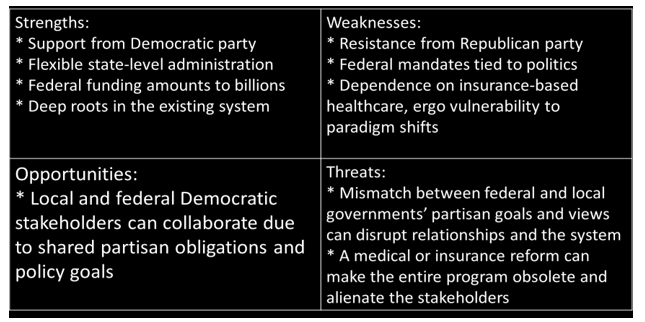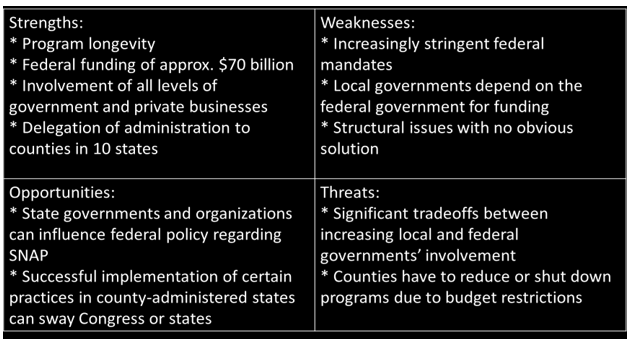Medicaid
Medicaid is the US social service that pays the hospitals for medical services rendered to qualifying citizens. It is aimed to be a safety net that helps low-income Americans receive the medical care they otherwise would not be able to afford. The states are not required to participate, but all of them do. The program is subject to federal legislation, such as the Affordable Care Act, and receives most of its funding from the federal government. However, local governments account for approximately 15-20% of the Medicaid budget, and approximately 5% of funding comes from various other sources (Medicaid and CHIP Payment and Access Commission, n.d.). The federal government has to supplement local budgets for hospitals in low-income areas, known as Disproportionate Share Hospitals, which would otherwise operate at an unsustainable loss (Mitchell, 2016). The program is structured in a way that involves all levels of the government.
Supplemental Nutrition Assistance Program
Supplemental Nutrition Assistance Program is a long-running state service that is aimed at providing food for low-income Americans. It was previously known as the Food Stamp Program but has undergone restructuring in 2008 to focus not just on food but on nutrition. SNAP provides various other services, such as supporting local small businesses or assisting with disaster relief. In ten states, counties administer the program according to their own judgment. While its funding comes from the federal government almost exclusively, those ten states pay for administering expenses out of their own local budgets (National Association of Counties, 2019). SNAP allows states and local governments a degree of freedom within the local mandates, which makes it very intergovernmental.
Medicaid SWOT

Within the existing system that widely employs medical insurance, Medicaid is a long-standing program. It is supported by stakeholders in all levels of governments and private businesses, deeply tied to the entire federalist picket. The federal government is unlikely to deem the program unnecessary, and its bulk and complexity require integration with local governments and care providers. Unfortunately, the decision-making regarding the relevant legislation is often driven by partisan conflicts (Rocco, Kelly, & Keller, 2018).
Loosely put, it means that Democratic support is one of the biggest strengths of Medicaid and its intergovernmental collaboration, while Republican resistance is one of its biggest weaknesses. As a consequence, officials whose policy preference aligns with Medicaid represent opportunities for federalist cooperation, while contrarian ones represent threats of intergovernmental competition. As Medicaid is contingent on insurance-based medical care, sweeping federal healthcare reform could render the entire program obsolete, which is another major threat that would alienate long-term stakeholders and decrease collaboration.
SNAP SWOT

The key strength of SNAP is its longevity: having existed since the Great Depression, the program has shown its utility and adaptability. It is funded almost exclusively by the federal government, which is a strength due to large sums of money and a weakness due to the exclusivity of the source. The program permits limited flexibility in its implementation but has been moving towards less intergovernmental collaboration. Federal agencies such as USDA can dictate rules to low-level governments and private businesses, reducing collaboration and increasing competition. However, there are still many debates regarding the issues inherent to SNAP, and constructively participating in these debates can help states and counties influence federal policy. The critical weakness of SNAP is that there are issues inherent to this kind of a social program with no clear solutions.
The major threat resulting from this weakness is that solving these problems can either shift responsibility disproportionately to the federal government, or leave states and counties with inadequate financial and institutional support (Oliveira, Prell, Tiehen, & Smallwood, 2018). Another threat to intergovernmental collaboration is the restrictions placed on counties regarding their funding (National Association of Counties, 2019). That results in counties sometimes reducing or shutting down programs due to limited budgets given to them by the federal government.
References
Medicaid and CHIP Payment and Access Commission (n.d.). Medicaid’s share of state budgets. Web.
Mitchell, A. (2016). Medicaid Disproportionate Share Hospital payments. Web.
National Association of Counties (2019). Understanding the county role in the Supplemental Nutrition Assistance Program. Web.
Oliveira, V., Prell, M., Tiehen, L., & Smallwood, D. (2018). Design issues in USDA’s Supplemental Nutrition Assistance Program: Looking ahead by looking back. Web.
Rocco, P., Kelly, A. S., & Keller, A. C. (2018). Politics at the cutting edge: Intergovernmental policy innovation in the Affordable Care Act. Publius: The Journal of Federalism, 48(3), 425–453.
